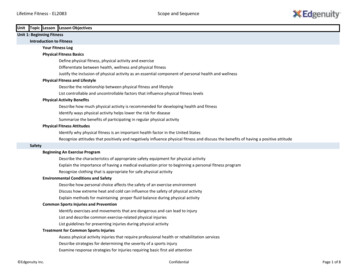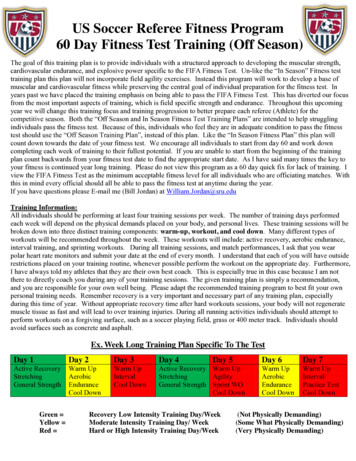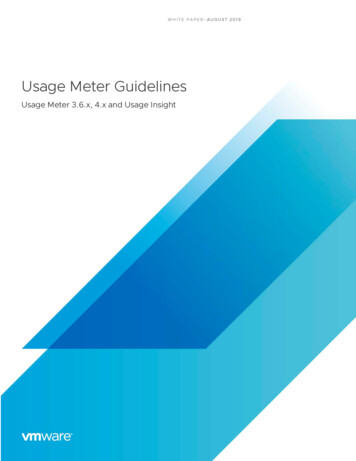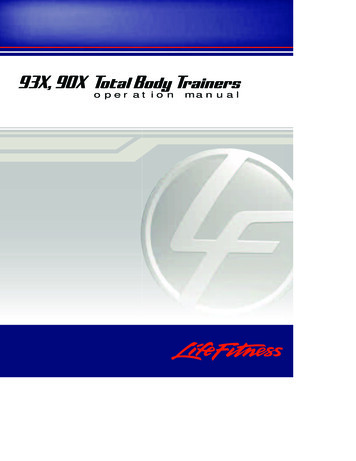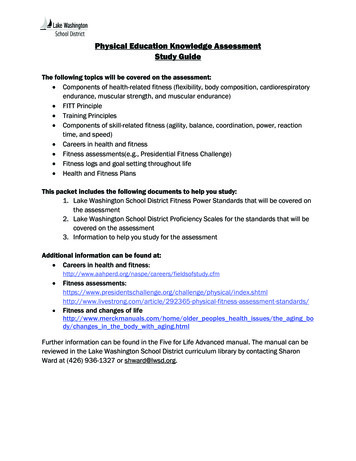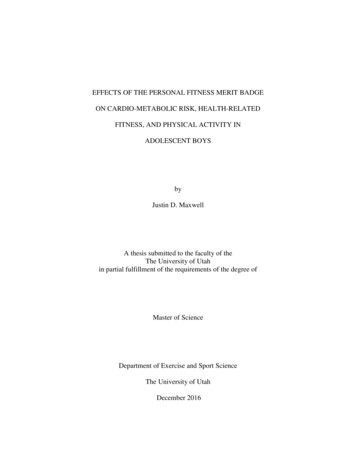
Transcription
Drive Fitness TestUsage InstructionsTo support World Wide WebRelease of DFT v3.6x26 May 2004 Hitachi Global Storage Technologies 2002Page 1 of 32
Table Of ContentsWhat is Drive Fitness Test? .3DFT System Fundamentals.3Creating a DFT Test Diskette .4Windows OS’s .4Linux OS’s.5DFT hardware support and restrictions.6SCSI Requirements:.7Running DFT .7Quick Test .12Advanced Test .16Advanced Topics .16Advanced Topics .17Menus .17Utilities.19Erase Boot Sector.21Erase Disk .23ATA Functions.27S.M.A.R.T Operations. .27Error Code and first aid for your drive .28DFT Error Codes.29Testing of Non-Hitachi/IBM Hard Disk Drives .30Supplied ASPI Managers .31Troubleshooting .32ASPI Manager Fails to Load .32Drives Attached to PCI IDE Adapter not seen by DFT .32Serial ATA Attached Drives.32 Hitachi Global Storage Technologies 2002Page 2 of 32
What is Drive Fitness Test?Hitachi offers a full line of 2.5 and 3.5-inch products with both high capacity and a diversity ofinterface options for high throughput operating environments, such as network and internet servers,multimedia production and digital video processingThe prime purpose of DFT is to test hard disk drives while they remain inside a personal computer,even when the primary operating system may no longer be bootable. This is suggested when it issuspected that there is a malfunction that could be related to the hard disk drive. This is helpful, asoften problems occur with data content and management that are unrelated to the function of thedisk drive itself. In these cases, a reload of the operating system, or similar recovery action, is allthat would be required to recover the computer. The use of DFT avoids unnecessary disturbance ofthe disk drive. This latest version of DFT has been enhanced to provide support for the latestHitachi drives and also the Serial-ATA interface.DFT is a DOS based utility and as such testing of the hard disk drive has no dependency on theoriginal Partition Format or Operating System that is installed on the disk drive.The basic Drive Fitness Test (i.e. Quick, Advance and Exerciser) is non-destructive, which meansthat it will not perform any write operations in the user data area. This option was chosen to ensurethe maximum integrity of user data.When run, the Drive Fitness Test will provide a result, from which the condition of the drive electronics and storage mechanism - can be determined. This can then be used to either choose tochange a drive that is defective, or take other actions to restore the functionality of the PC. A furtherdiagnosis may determine that the drive has been subjected to handling damage.In the event that you have a Hitachi/IBM drive which is reported by DFT as defective, then you willbe provided with a Technical Return Code (TRC) which will allow you to check and if appropriategenerate a Returns Material Authorisation (RMA) via our web based warranty support process.NOTE: DFT currently will NOT generate a TRC for failed drives that were not manufactured byIBM.In addition to hard drive testing, DFT contains utilities, which allows the following: S.M.A.R.T (Self-Monitoring, Analysis and Reporting Technology) to be enabled or disabled.Erasure of the disk Master Boot SectorTotal Erasure of the data in the user area of the diskView useful information about the drive, e.g. Microcode level, Specification Compliance.More information and background about DFT is available T System FundamentalsThe Drive Fitness Test currently provides for in-depth testing of Hitachi Global StorageTechnologies and legacy IBM disk drives and basic testing of Other Manufacturers drives. Thisnew version will support standard disk drives with the ATA/IDE, Serial-ATA and SCSI interfaces.The basic tests will not overwrite customer data. Hitachi Global Storage Technologies 2002Page 3 of 32
The Drive Fitness Test (DFT) application is designed to run under native DOS (i.e. not a DOSwindow of any OS) and is distributed as an executable file DFT32-Vxxx.exe (where xxx may vary),over the Internet, or as a prepared floppy diskette. If the file has been received via a Internetdownload you will need to follow one of the procedures below to prepare a test diskette.If you have received a prepared floppy, proceed to the section below entitled DFT HardwareSupport and Restrictions.Creating a DFT Test DisketteWindows OS’sThe Drive Fitness Test set-up program ( DFT32-Vxxx.exe ) includes IBM PC DOS2000 and theDrive Fitness Test Utility. In order to run the set-up program you will need to have a formatted1.44-MB diskette and access to a system that is running one of the following operating systems,Windows’95, Windows’98, Windows Millennium, Windows NT, Windows 2000 or Windows XP.Running the set-up program creates an IBM PC DOS2000 bootable diskette that contains the DriveFitness Test and all required supporting programs.It is recommended that before starting the set-up program, all open Windows applications should beclosed.The following represents two examples of how the DFT diskette can be created.Method A.1. Insert a formatted diskette into the Floppy drive, (A: or B:).2. Using Windows Explorer, locate the program DFT32-Vxxx.exe downloaded from theInternet.3. To start diskette creation, double-click on the program icon and follow the on screeninstructions. Note: you have the option to select your country location and keyboardlayout, the default for these options is United States.Method B.1.2.3.4.5.Click Start, then select Run.Click the Browse button to locate the DFT32-Vxxx.exe set-up program.Click on the filename, then click Open.Click OK to run the DFT32-Vxxx.exe set-up program.Insert a formatted 1.44-MB diskette into the required floppy drive ( A or B if yoursystem has 2 floppy drives ), select the target floppy on the set-up screen then click nextto continue.6. Follow the on screen instructions. Hitachi Global Storage Technologies 2002Page 4 of 32
Linux OS’sThe Drive Fitness Test image file (e.g. DFT-v300img.bin) includes IBM PC DOS2000 and theDrive Fitness Test. The name of the image file will change according to the release version of DFT.Running the Linux Disk Dump (DD) utility creates an IBM PC DOS 2000 bootable diskette thatcontains the Drive Fitness Test Utility.A formatted 1.44-MB diskette is required to create the DFT diskette.To create the bootable DFT diskette under Linux:1. Download the DFT image file (DFT-v3xximg.bin) into a known directory on your PC.2. Insert a formatted 1.44-MB diskette into your floppy disk drive.3. Make sure that the floppy disk is un-mounted.4. Change directory to where you saved the DFT image.5. Run the Disk Dump (DD) utility with the following parameters:DD if dft-v3xximg.bin of /dev/fd0 bs 8k6. The bootable DFT diskette will now be created, Note this could take a couple of minutes. Hitachi Global Storage Technologies 2002Page 5 of 32
DFT hardware support and restrictionsDFT is designed to run on ATA, Serial-ATA and SCSI attached disk drives. From version 2.1onwards DFT also supports testing of disk drives that have been manufactured by OEMmanufactures (i.e. not Hitachi or IBM) in addition to Hitachi/IBM. However the depth of testingthat is carried out on the non-IBM/Hitachi drives will be less than that performed on theHitachi/IBM drives. Disk Erasure and Erase Master Boot Sector functions are not supported onnon-Hitachi/IBM drives.DFT will run on SCSI drives if these drives are attached to SCSI controllers that have a DOS ASPIlayer, which supports hard disk drives. Some SCSI controllers have ASPI layers that offer supportonly for removable media devices e.g. CD-ROM’s, Tape etc. if you have this type of controller aASPI Manager that allows hard disk support will be required in order to test your SCSI hard diskdrives using DFT. DFT is supplied with a small number of DOS ASPI Managers supporting themost popular SCSI controllers.DFT supports UDMA/33, UDMA/66, and UDMA/100 plug-in PCI-to-ATA adapters from Promise Technologies, CMD, I’Will, Silicon Image and Highpoint. ATA motherboard controllers based on the Highpoint HPT366, HPT370 andHPT372 chipset, the Promise Ultra 100 and Ultra100TX2 chipsets.Windows sees these adapters as SCSI controllers through a non-standard architecture and drivesattached to these adapters will be reported as being attached via PCI adapters.From release 3.50, DFT supports Hitachi Serial-ATA drives when these drives are attached to Motherboards and Plug-in PCI controllers, which utilises the Highpoint HPT374(with Marvel bridge chip) chipset.Configurations NOT supported: Drives attached using ATA RAID controllers where direct access to the attacheddevices is blocked by the controller also not supported are Multi-Channel SCSIRAID controllers. Serial-ATA controllers based on the Silicon Image Promise and Intel chipsets arenot currently supportedThe references made in this document to Hitachi drives, refers to drives that were manufactured bythe newly formed Hitachi Global Storage Technologies Company. Drives, which were designed bythe Hitachi Drive Company and in manufacture prior to January 2003, will be treaded as OEMdrives by DFT, however the utility has been enhanced to allow the Erase MBR & Erase Diskfunctions to be performed on these drives. Hitachi Global Storage Technologies 2002Page 6 of 32
SCSI Requirements:To test SCSI drives DFT requires a DOS loadable ASPI manager for the SCSI Controller that thedrives are attached to. Note: Some ASPI managers offer support only for removable media devicese.g. CD-ROM’s, Tape etc. check the documentation that was supplied with your SCSI controllers orcontact your SCSI controller supplier to see if this is the type of ASPI managers you have.DFT is supplied with ASPI managers that support several different types of SCSI controllers, seethe section ‘Supplied ASPI Managers’ at the end of this document. If your SCSI controller is notlisted you will need to obtain a DOS ASPI manager that supports your controller. Check thesoftware supplied with your controller or visit the web page of your controller manufacturer.Having obtained a DOS loadable ASPI manager you will need to update the DFT diskette asfollows,1. Copy the ASPI manager program(s) to the ASPI sub-directory on the diskette.2. Using a text editor (e.g. Notepad, Wordpad etc.) edit the file Config.sys on the disketteto include the ASPI manager under the SCSI heading.e.g. DEVICE A:\ASPI\abcdef.sys where adcdef.sys is the name of your ASPI manager.(Your controller documentation should detail how to add a ASPI manager to aconfiguration file).Running DFTPlace the prepared floppy disk in the system to be tested and boot the system either by powering offthen on or pressing the reset button or by pressing the Ctrl Alt Delete keys.When the system restarts you will be offered a menu with two options1. SCSI and ATA support2. ATA support onlyBy default option 1 is selected, this will take you to a second menu screen where you can selectfrom a range of SCSI Controller manufacturers.Note: the default on the second menu is to load ASPI’s to support Adaptec,Buslogic, DPT and INITIO Controllers, if the relevant SCSI controller is notinstalled in the system an error message may be displayed on the screen. This isnormal and isn’t a problem.Select option 2 if you have only or wish to test only ATA and/or Serial-ATA drives. Hitachi Global Storage Technologies 2002Page 7 of 32
DFT will load automatically and present you with the License Agreement as shown below.This is a license agreement, which you should review prior to accepting using the “I Agree” button.The positioning and tab keys can be used to navigate through the license agreement and also thebutton selection.The program will progress only if you accept the license agreement by selecting the ‘I agree’button. DFT will then analyse the connected drives and display to the screen belowIf the drives in the list represents what you know to be installed in your system then you shouldpress the Yes button, after which you will be presented with the main DFT Test Menu, see page 11. Hitachi Global Storage Technologies 2002Page 8 of 32
If the list doesn’t contain the drive(s) that you wish to test then select No, you will be presentedwith the screen below. This window provides information about cabling and jumper settings, whichcould have prevented your drive from being detected, please power-off your system and check thatyour drive is correctly installed and re-start the DFT test.NOTE: the following applies for non-detected Hitachi/Legacy IBM drives onlyIf you have made all the checks and your drive is still not detected then press the continue button,after which you will be presented with the following screen, type in the serial number of the drivethat DFT failed to detect and press OK to continue. Hitachi Global Storage Technologies 2002Page 9 of 32
The following screen shows the Technical Result Code window, this window contains informationwhich you will require in order to use the Hitachi web based warranty process or when calling theTechnical Support Centre. Please make record this information and press OK when finished.If this is the only Hitachi Global Storage Technology or Legacy IBM drive in your system or theonly drive you wished to test when the main DFT Test Menu is displayed (see the following page)you can exit the program and shutdown your machine. Hitachi Global Storage Technologies 2002Page 10 of 32
The following shows the main DFT Test Menu screen,In this example, there are four drives visible in the Device List menu. One ATA hard disk isattached to the primary ATA port on the motherboard, one ATAPI DVD-ROM attached to thesecondary ATA port on the motherboard and two other ATA hard disk attached to either a onmotherboard or plug-in PCI ATA adapter. If more that 4 devices are installed then the side scrollbar can be used to view the additional drives. In the current menu screen, above, the primary masterATA drive has been selected. The test path generally taken is to run the Quick Test simply bypressing the Enter key. Hitachi Global Storage Technologies 2002Page 11 of 32
Quick TestThis leads to the next screen. Here the test is ready to start on the selected drive.All that needs to be done is to press enter again to Start the test, which is seen running in the nextscreen.In the screen above, the DFT test is running. The name of the active part of the test is displayedabove the progress bar, (in this example - Analysing Media). The progress bar illustrates progressthrough the active test stage. DFT execution for the Quick Test should be less than 3 minutes inmost circumstances. Hitachi Global Storage Technologies 2002Page 12 of 32
During testing DFT only performs read operations in the user data area, so your data files will notbe overwritten. Write operations will ONLY be performed if you select the options to erase disk orerase MBR from the Utility Menu or by selecting these options when offered after a media error hasbeen detected.The screen above shows the conclusion of a test. In this case, the drive passed the DFT testing.What does passing Quick Test mean if my system is not starting up correctly?If the system is failing to boot (start up), then your next steps may be to- proceed to check all of the data on the drive using Advanced Test (described below)- analyse the PC in other ways, in particular with respect to rebuilding the operatingsystem (usually one of the Windows OS’s). Please review the PC and operatingsystem manuals and use PC manufacturers support lines if appropriate.If the test should fail and the cause of failure is due to a media error (for example a bad write) thenyou will be presented with a screen similar to that shown below. Hitachi Global Storage Technologies 2002Page 13 of 32
In most cases when DFT reports a media error this is because the data in a sector cannot be read dueto corruption. These corrupted sectors can be recovered by being re-written, see options below.1. Run Erase Disk, or2. ReturnFor more information on Erase Disk see the relevant sections of this document.NOTE –Erase Disk WILL result in data being delete from your disk drive, only perform theseactivity if your data has been backed-up or you can afford to lose the data on your drive. Formore details of what erase disk does see the relevant section in this user guide.If you choose not to repair the drive by selecting the Return option above, or if the cause of failurewasn’t due to a media defect you will be presented with a screen as shown below. In this examplethe screen shows a non-media test failure.The failing return code 0x72 represents a S.M.A.R.T. error. The S.M.A.R.T. system is a diskdrive’s way of notifying of possible failure in the future (see Utilities Section of this document formore information on S.M.A.R.T).In all cases of test failure a screen displaying a Technical Result Code (TRC) similar to that shownabove will be displayed.The test result should be noted. It may be required in discussion with your supplier or supportcentre in order to take steps to replace the hard drive or to obtain a RMA (Return MaterialsAuthorisation) through the Hitachi web based warranty process. Hitachi Global Storage Technologies 2002Page 14 of 32
If a test is stopped, for example by pressing the cancel button, the following screen will appear.Selecting Yes will cause the test to be stopped as shown in the following screen.This says that testing has not been completed, and is not a statement of either pass or fail. Testingmust be restarted and run to completion in order to assess if there is a problem with the drive. Thereturn code 0x10 is not an error. Hitachi Global Storage Technologies 2002Page 15 of 32
Advanced TestIf the Advanced Test option is selected, testing is similar to Quick Test, but all of the data area ofthe selected disk drive will be tested.DFT only performs a read test in the user data area, so your data will not be overwritten. Executiontime will normally be in the order of 40 minutes, but this can be longer for very large capacitydrives. Test progress will be illustrated as shown below. Hitachi Global Storage Technologies 2002Page 16 of 32
Advanced TopicsMenusUse the F10 key or the mouse to access menu items at the top of the main test screen, as illustratedbelow. These are generally a repeat of functions already displayed but also allow access toadditional tests and utilities.The Exerciser test, as shown in the next screen, can be accessed from the menu or by using the hotkey combination Alt E. Hitachi Global Storage Technologies 2002Page 17 of 32
The Exerciser is basically the Advanced Test with the addition of a number of 30-minute drivetests. The number of 30-minute periods can be set in the following option screen. The pass / fail /abort mechanism are similar to that of Quick Test. Hitachi Global Storage Technologies 2002Page 18 of 32
UtilitiesThe Utilities menu as shown below, gives you access to several useful tools. These should be usedwith CARE, for unlike the test described earlier the Erase Boot Sector, Erase Disk and SectorRepair utilities WILL permanently erase data from your drive(s).Selection of the Drive Info. Option as shown above will display useful information about theselected drive, see following screen. This information could be useful if you need to report aproblem back to your drive supplier or Hitachi. Hitachi Global Storage Technologies 2002Page 19 of 32
The drive information displayed above can be saved to a text file in the DATA sub-directory on thefloppy drive. The default name of the text file is DRVINFO.TXT as shown below, you can change thefilename by over typing this name with, for example, the drive serial number.The following screen will be displayed to confirm that the file has been saved. Hitachi Global Storage Technologies 2002Page 20 of 32
Erase Boot SectorThe boot sector of a disk contains the start-up programs for your operating system, it also containsinformation about how your disk is partitioned. If this sector becomes corrupted in any way and thisis your boot drive you may not be able to start your system or access data on the drive. Reinstallation of your operating system in a small number of cases may not fix the problem, for thesecases you will need to erase the boot sector, partition the drive and re-install your operating system.This utility will erase the boot sector by over writing the original information in this sector withzeros. It can be used with both IDE and SCSI drives.Selecting Erase Boot Sector from the Utilities menu above will display the following screenThis utility will overwrite data on your hard drive, to ensure that you really wish to do this you willbe presented with several confirmation screens as shown below, select YES in each case to continue. Hitachi Global Storage Technologies 2002Page 21 of 32
When the following screen is displayed press the start button to erase the master boot sector.The following screen will be displayed when the operation has been completed successfully. Hitachi Global Storage Technologies 2002Page 22 of 32
Erase DiskThis utility will write zeroes to every sector of your hard drive including the boot sector, and can beused with both IDE and SCSI drives. This utility is meant to be used to clean-up disk which haveerrors written to the media (e.g. where a system has been powered off whilst writing data out to thedrive). This utility can take a long time to run (more than an hour) depending on the capacity of thedrive and the system configuration.Selecting Erase Disk from the Utilities menu above will display the following screenAs with the Erase Boot Sector utility, Erase Disk will overwrite data on your hard drive, to ensurethat you really wish to do this you will be presented with several confirmation screens as shownbelow, select yes in each case to continue. Hitachi Global Storage Technologies 2002Page 23 of 32
Hitachi Global Storage Technologies 2002Page 24 of 32
When the following screen appears, pressing the start button will result in your hard disk drivebeing erased.Progress will be illustrated as shown below, note there may be a small delay before the progress baris updated. Hitachi Global Storage Technologies 2002Page 25 of 32
After completing the erasure of the disk a sequential read of the disk is carried out to verify that allsectors have been initialised.The following screen will be displayed when the operation has been completed successfully. Hitachi Global Storage Technologies 2002Page 26 of 32
ATA FunctionsS.M.A.R.T Operations.S.M.A.R.T. - Self-Monitoring, Analysis and Reporting Technology is intended to protect user dataand prevent unscheduled system downtime that may be caused by predictable degradation and/orfault of the disk device. By monitoring and storing critical performance and calibration parameters,S.M.A.R.T. devices employ sophisticated data analysis algorithms to predict the likelihood of nearterm degradation or fault conditions.To enable/disable S.M.A.R.T., select S.M.A.R.T. Operations from the utilities menu as shownabove, S.M.A.R.T. can now be enabled or disabled on the selected drive by selecting enable/disableas shown below. Hitachi Global Storage Technologies 2002Page 27 of 32
Error Code and first aid for your driveThe following table defines all the currently supported DFT error codes. For example if duringtesting of your hard drive DFT reports a error code of 0x70 as shown on page 14, this indicates thatyour hard disk drive has problems reading one or more of its sectors. In most of these cases thedrive can heal itself of these errors. To do this first back-up all your data from the problem drive ( ifpossible ) then run DFT again and select the Erase Disk option which is under the Utility heading.If you already have a backup of the data on the hard disk or the data isn’t important you can opt torun Erase Disk from the Test Result screen. Once the selected operation has completed you canthen run one of the test options Quick or Advance to confirm that the drive has been healed. Theresult code, which should be displayed, is 0x00 if the test returns another code then you shouldcheck with your drive/system vendor if the drive can be return for warranty replacement. Hitachi Global Storage Technologies 2002Page 28 of 32
DFT Error CodesCodesDescription0x00No Error0x10Test aborted by user.0x200x21Command complete successfully.The current test was cancelled by user and cannot be completed. Rerun the test to conclusionSelected device not present.The selected device could not be found on the selected port. Check cabling and HDD connectors. If thedrive is not seen by the BIOS or is not spinningATA Master device not present.An attempt was made to test an ATA Slave device, but an ATA Master cannot be detected. A Master mustbe present to test a Slave. Check cabling and HDD connectors.0x22Device Protected,0x23Format Degraded.0x300x31Selected device is protected by a password. The drive is write and read protected and cannot be testedA SCSI low-level format was interrupted.Out of memory.There’s not enough memory to execute this program.Wrong parameter.There is a wrong or unknown parameter.0x33Function cannot be executed on this device.System interrupts the current operation.0x40The System has interrupted the current operation, and the function was aborted. Please exit the programand check if any Power Saving Modes or Cache Programs (like SMARTDRV.EXE) are active. Disablethose features and start this program again.0x410x420x43Bad cable.A data miss compare was detected during the cable test.Drive temperature problem.The drive has exceeded the drive temperature limitPending SCSI request.The ASPI Device driver could not complete the SCSI request block. Check the SCSI configuration(cabling, termination, Ids etc.).System Vibration0x44The level of vibration that the drive is experiencing is excessive, check the mounting of the drive in thesystem and ensure it is rigidly mounted. If possible try mounting the drive in a different position.0x45Low System PerformanceCorrupted Sector.0x700x710x720x730x740x75A general hard disk drive problem was detected. You can run the "Erase Disk" utility. If a subsequent testfails again, the drive is defective and should be replaced.Device not ready.The selected drive is not ready for operation. Check cabling and HDD connectors.Device S.M.A.R.T. Error.The Self-Monitoring, Analysis and Reporting Technology (S.M.A.R.T.) has detected a drive problem.The drive may fail soon and should be replaced as soon as possible.Device damaged by shock.This device was damaged by an excessive shockS.M.A.R.T Self-test failedAn error was detected during S.M.A.R.T. self-test. You can run the "Erase Disk" utility of DFT. If asubsequent test fails ag
Windows sees these adapters as SCSI controllers through a non-standard architecture and drives attached to these adapters will be reported as being attached via PCI adapters. From release 3.50, DFT supports Hitachi Serial-ATA drives when these drives are attached to Motherboards and Plug-in PCI controllers, which utilises the Highpoint HPT374
